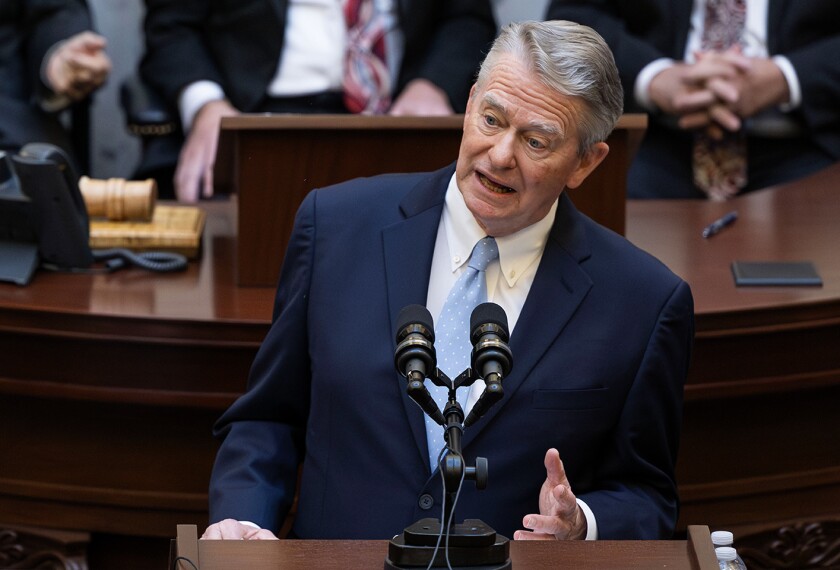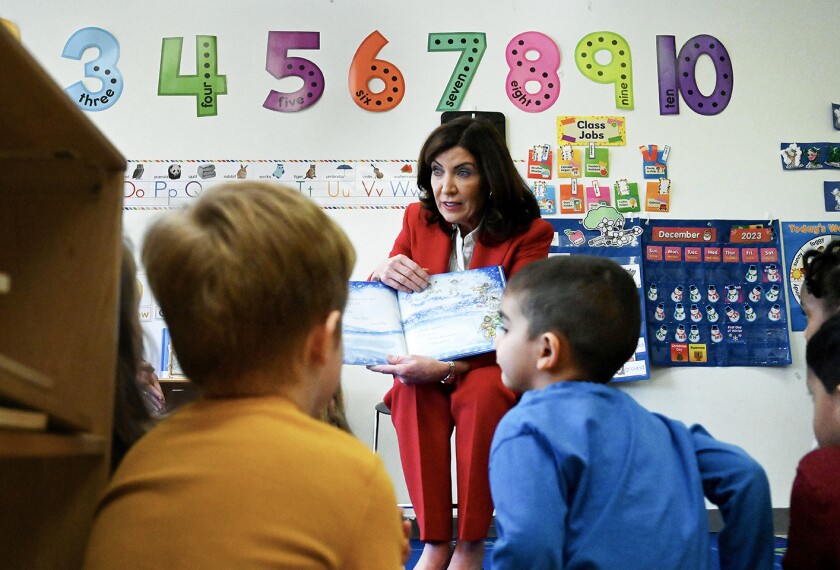Idaho Gov. Brad Little made a big announcement on Jan. 8 during his annual State of the State address: He’s proposing a $2 billion investment, the largest in state history, to renovate and modernize the state’s school buildings.
The announcement was notable for several reasons.
Idaho was recently the subject of a series of investigative articles by ProPublica and the Idaho Statesman that exposed dismal and even unsafe conditions in many of the state’s schools.
The Gem State, the news organizations reported, spends less per student on school infrastructure than any other state.
Little’s proposed investment in the state’s school buildings would be significant. But it comes as federal COVID relief aid dries up and state tax revenues are projected to fall, limiting the available resources for major school facility investments.
Little, a Republican, is proposing to spend $1 billion in sales tax revenue over the next 10 years—without raising the state sales tax rate—and to provide schools with the other $1 billion by issuing a bond.
The Idaho news highlights the precarious position state leaders face as they aim to balance tighter finances with sometimes significant investments in K-12 education.
More than half of state governors have signaled their K-12 priorities for the year during annual State of the State addresses over the last few weeks.
Many states, however, appear to be focusing on relatively low-cost initiatives—investments in reading instruction and salary bumps for school staff, for instances—rather than major upfront investments, said David Bloomfield, professor of educational leadership, law, and policy at Brooklyn College and the City University of New York Graduate Center.
Bloomfield thinks governors are holding back on big-ticket investments without directly saying as much.
“It’s easy to inveigh against the quality of teacher preparation and literacy instruction. You can throw a little bit of money into that, and call it an initiative,” Bloomfield said. “But they’re pretty cost-free, whereas major initiatives such as pre-K and child care are too costly in the current environment.”
In Idaho, half the proposed investment in school facilities would come via a bond—borrowed money to be paid back later, with interest.
States supply roughly 45 percent of the funds school districts nationwide use to pay teachers, purchase supplies, and keep buses running. They have significant power to effect change in curriculum standards. And their policies around private school choice, charter schools, and school facilities play a major role in shaping the range and quality of educational options available to students.
That’s why governors’ State of the State addresses are important signals of changes schools can look out for in the coming years that could affect their budgets and day-to-day operations.
The research organizations FutureEd and the Education Commission of the States are documenting education-related topics that arise during governors’ speeches this winter. Here are a few key themes that have come up in several State of the State addresses in recent weeks, signaling that they’ll be major priorities across the country.
Focus on reading instruction
The nationwide debate over literacy instruction—how to do it well, and how to help students recover from major shortfalls in test results—continues to be a major education focus among state governors.
Massachusetts Gov. Maura Healey used her State of the Commonwealth address to announce a new state education department effort called Literacy Launch that will help ensure districts have the resources and training they need to align reading instruction with the most up-to-date, research-based practices.
South Carolina Gov. Henry McMaster set a goal of ensuring that all children are reading on grade level by the end of 3rd grade.
And New Mexico Gov. Michelle Lujan Grisham announced proposed investments of $60 million for a statewide literacy institute and free summer programs accessible to up to 10,000 students.
Governors in Indiana, Iowa, and New Jersey also mentioned the importance of boosting reading instruction in their speeches.
Pay raises for educators
Lagging pay for teachers and other educators is a perennial issue in education policy, and it has come up often as governors have signaled K-12 priorities for the year.
In particular, at least five Republican governors offered proposals for raising teacher pay:
- Ron DeSantis in Florida: $1.25 billion in the state budget for raises
- Kim Reynolds in Iowa: Increase teachers’ starting pay to $50,000 and the minimum salary for teachers with 12 years of experience to $62,000
- Mike Parson in Missouri: Increase starting pay to $40,000
- McMaster in South Carolina: Increase starting pay to $45,000 and shoot for a $50,000 minimum by 2026
- Jim Justice in West Virginia: Raise pay for all educators by 5 percent
Governors in Kentucky, South Dakota, and Washington also included pay raises for educators among the proposals they cited in their speeches.
Charters and private school choice
Comments for and against private school choice programs like vouchers and education savings accounts have shown up in states where politicians have supported expanding those programs or want to limit them. Republican governors in Georgia, Nebraska, and South Carolina vowed to defend existing private school choice programs or establish new ones. Democrats leading Arizona and Kansas vowed to rein in private school choice programs or continue to oppose them altogether.
Charter schools haven’t generated as much media coverage as recent efforts around vouchers and education savings accounts, but several states are aiming to expand them. West Virginia Gov. Jim Justice proposed $5 million to help open new charter schools. Colorado Gov. Jared Polis wants to ensure that charter schools have the same access to raise local revenue as local school districts do. And Little in Idaho wants to cut regulations so charter schools have fewer hurdles to overcome in trying to open.
Montana, meanwhile, just approved more than a dozen charter schools, to be operated by local districts, as part of its newly passed charter school program. Another new charter mechanism in the state, which establishes a separate board to review charter proposals from private entities, has been temporarily halted while a court determines its fate.
Three top-of-mind topics that haven’t come up much
Governors have largely avoided a handful of topics that are among the most-discussed in K-12 education. They include:
- School safety: Shootings in and around schools continue to be a major concern—but state governors, with some exceptions, haven’t addressed the issue much. “It tends not to be a statewide issue, both as a political and operational matter,” Bloomfield said. Still, he’s surprised governors have largely talked about gun safety as a society-wide issue, without much focus on the devastating effects of guns in schools.
- Artificial intelligence: The rapid emergence of sophisticated technology tools that obey commands is only beginning to transform how students learn and schools operate. Most states appear not to have developed coherent legislative solutions to thorny questions about the role AI tools should play in schools, Bloomfield said.
- Diversity, equity, and inclusion initiatives; book bans; and policies targeting transgender students: Despite heated political rhetoric over what literary content children should consume and experience in schools, and what rights LGBTQ+ students should have, even the most conservative governors haven’t devoted much time to these issues in speeches so far this year. “The damage has been done in many states already,” Bloomfield said. Plus, “I think the page has turned on those issues as electoral winners.”












